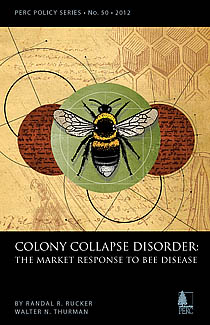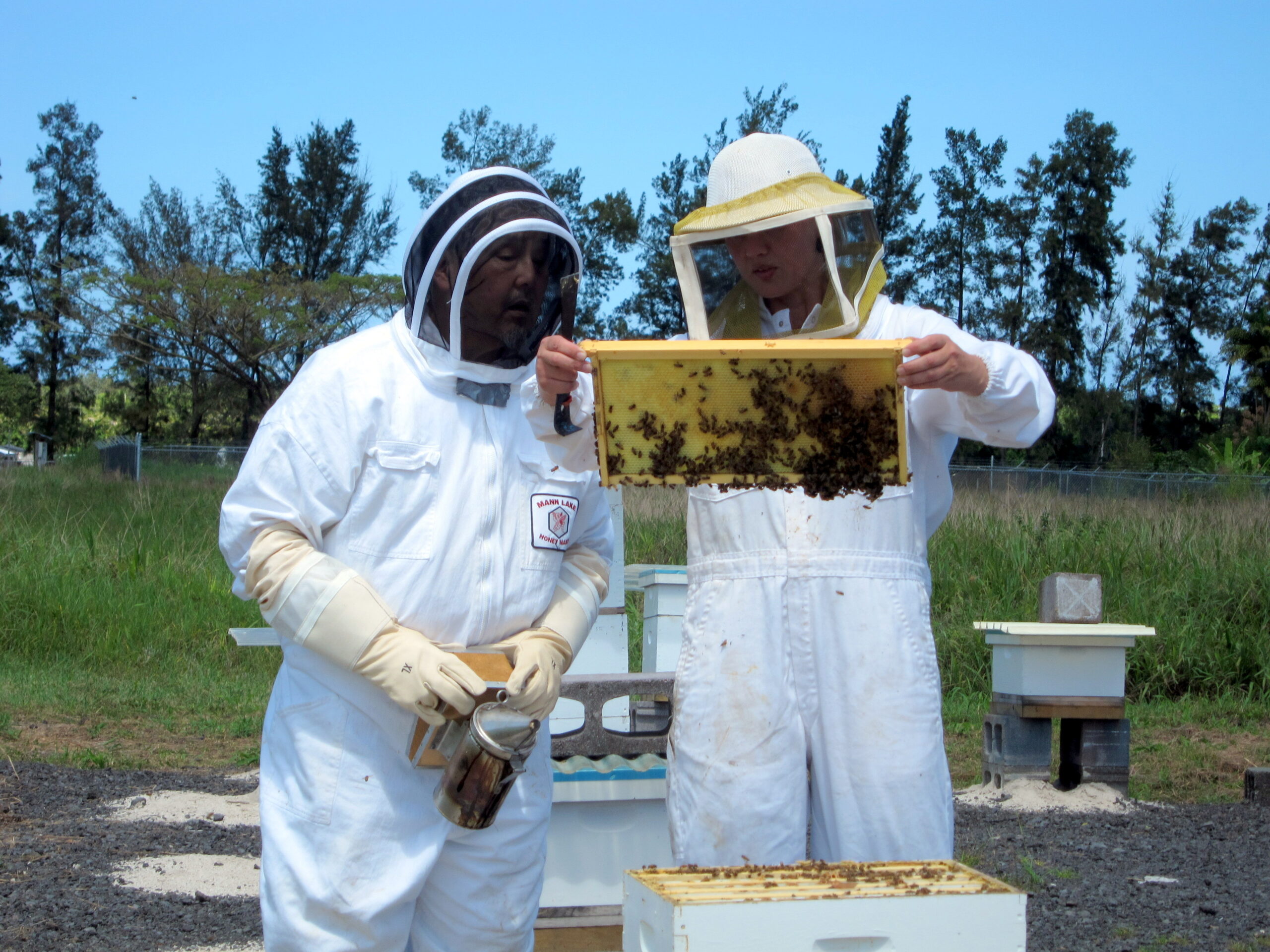This post originally appeared at the Conversable Economist.
President Obama has released a “Presidential Memorandum — Creating a Federal Strategy to Promote the Health of Honey Bees and Other Pollinators” (June 20, 2014). The report begins:
“Pollinators contribute substantially to the economy of the United States and are vital to keeping fruits, nuts, and vegetables in our diets. Honey bee pollination alone adds more than $15 billion in value to agricultural crops each year in the United States. Over the past few decades, there has been a significant loss of pollinators, including honey bees, native bees, birds, bats, and butterflies, from the environment. The problem is serious and requires immediate attention to ensure the sustainability of our food production systems, avoid additional economic impact on the agricultural sector, and protect the health of the environment…
The continued loss of commercial honey bee colonies poses a threat to the economic stability of commercial beekeeping and pollination operations in the United States, which could have profound implications for agriculture and food. Severe yearly declines create concern that bee colony losses could reach a point from which the commercial pollination industry would not be able to adequately recover. The loss of native bees, which also play a key role in pollination of crops, is much less studied, but many native bee species are believed to be in decline. Scientists believe that bee losses are likely caused by a combination of stressors, including poor bee nutrition, loss of forage lands, parasites, pathogens, lack of genetic diversity, and exposure to pesticides.”
For economists, the theory of externalities had been around since the 1920s, expecially in the work of A.C. Pigou and his 1920 book, The Economics of Welfare. Basically, the notion is that situations can arise in economic production when private cost to the producer is not the same as social cost. For example, if a firm can emit pollution without restraint, then the firm bears no private cost of doing so, but society bears a social cost from that pollution. When this kind of “externality” arises, there can be a role for government to require (in this case) the firm to bear the cost of the pollution that it emits. However, a few decades after Pigou, economists had not identified many real-world examples of such divergences between private and social costs other than pollution.
In a 1952 article, James Meade suggested the example of bees living near an apple orchard (Economic Journal, “External Economies and Diseconomies in a Competitive Situation”). Meade argued that if an apple farmer considered increasing the size of the orchard, part of the benefit would be that nearby bees could produce more honey–but the apple farmer would not benefit from this additional honey, and thus had a reduced incentive to increase the size of the orchard. Similarly, if a beekeeper was considering an increase in the number of bees, part of the benefit would be greater pollination that would raise the size of the apple harvest–but the beekeeper had no way to benefit from a larger apple harvest, and thus had a reduced incentive to increase the number of bees.
In this situation, both apple farmers and beekeepers could benefit from expanding together, but acting individually, they had an inappropriately low incentive to do so. In Meade’s scenario, their private benefits from expanding didn’t match the social benefits of doing so. Meade saw this as an example of where government intervention in markets might be useful, writing that “we can obtain formulae to show what subsidies and taxes must be imposed.” A couple of generations of introductory economics teachers faithfully told stories to their students about how private markets would fail to work well in the case of apple orchards and bees.
However, in 1960 Ronald Coase published his famous article, “The Problem of Social Cost” (Journal of Law and Economics, October 1960, available at various places on the web including here). Coase pointed out that many problems of externalities could be considered in terms of property rights: In one famous example, if a farmer has a property right not to have sparks from a train engine set the fields afire, then the train will need to pay to reduce such sparks; if the train has a property right to emit sparks, then the farmer will need to pay to reduce the sparks. Thus, the government doesn’t need to regulate sparks from trains: it only has to make the property rights clear, and let the parties act accordingly.
In 1973, Stephen Cheung applied Coase-style logic of property rights to “The Fable of the Bees: An Economic Investigation” (Journal of Law and Economics, April 1973, available various places including here). Cheung pointed out that while Meade and others had interpreted the externality of bees as a reason for government subsidies and taxes, the actual real-life beekeeper industry had dealt with the issue through property rights. Cheung was writing from the University of Washington, close to actual apple-growing country. He noted, a bit acerbically:
It is easy to understand why the “apples and bees” example has enjoyed widespread popularity. It has freshness and charm: the pastoral scene, with its elfin image of bees collecting nectar from apple blossoms, has captured the imagination of economists and students alike. However, the universal credence given to the lighthearted fable is surprising; for in the United States, at least, contractual arrangements between farmers and beekeepers have long been routine. This paper investigates the pricing and contractual arrangements of the beekeeping industry in the state of Washington, the location having been selected because the Pacific Northwest is one of the largest apple-growing areas in the world.
Contrary to what most of us have thought, apple blossoms yield little or no honey. But it is true that bees provide valuable pollination services for apples and other plants, and that many other plants do yield lucrative honey crops. In any event, it will be shown that the observed pricing and contractual arrangements governing nectar and pollination services are consistent with efficient allocation of resources.
Much detail followed about how beekeepers actually move and locate their hives across different areas and crops throughout the year, along with the contractual arrangements beekeepers actually were reaching with farmers. In short, while economists like Meade were hypothesizing about how markets couldn’t address the issues of bees, actual beekeepers in real market were signing contracts that seemed to address these problems just fine.
What about the modern problems with bees? In “Colony Collapse Disorder: The Market Response to Bee Disease,” Randal R. Rucker and Walter N. Thurman take a Cheung-like perspective in a 2012 paper written for the Property and Environment Research Center (PERC). From the overview: “Too often it is presumed when reading about environmental issues in the doom-and-gloom media that
politicians are needed to save the day. In the case of colony collapse, luckily it never got to political intervention. As is often the case, the uncoordinated market quietly resolved what had been posited as a major crisis.”
Colony collapse was a real problem. As Rucker and Thurman write (citations omitted):
In October 2006, David Hackenberg, a Pennsylvania beekeeper, took 3,000 honey bee (Apis mellifera) colonies to Florida for the winter. In mid-November, when he checked on the hives he had left in Tampa, he discovered that 360 out of 400 were practically empty—there were no adult bees in the hives and no dead bees in or near the hives. On further investigation, he found that roughly 2,000 of the hives he had taken to Florida had been wiped out. Hackenberg began making phone calls describing his losses, and within a week other beekeepers were reporting similar experiences. In February 2007, reports of this new bee affliction made national news and was christened Colony Collapse Disorder. … Between 2007 and 2011, approximately 30 percent of U.S. bees alive each fall failed to survive to pollinate blossoms in the spring. Widespread die-offs due to disease have long been recorded, but CCD has been worse than most.
Of course, colony collapse disorder quickly became a sort of Rorschach test for environmental policy, where just about any possible environmental problem was listed as a possible case of the bee problems.
Rucker and Thurman point out that outbreaks of bee disease are not new: reading their article is your chance to get up to speed on varroa mites, tracheal mites, the bacterial infection called American foulbrood, and the nosema and chalkbrood fungus. Colony collapse disorder doesn’t seem to have a single cause, but two bee pathogens not previously active in the U.S. seem to be playing a role: in case you need to know, they are the Israeli Acute Paralysis Virus and and adult honey microsporidian parasite called Nosema ceranae.

The USDA collects information on the U.S. honey industry: for example, see Tables 46-48 in this 2014 report. Their data shows 2.6 million bee colonies in 2013, which is roughly the same total going back to the mid-1990s, and slightly higher than the totals in 2005 and 2006, before colony collapse disorder hit. The data also shows a decline in U.S. honey production from highs of about 220 million pounds for some years in the 1990s down to a little under 150 million pounds in 2011, 2012, and 2013. However, imported honey has been on the rise. U.S. honey import were in the range of 150-200 million pounds per year in the late 1990s, but have climbed to reach 323 million pounds in 2013. Of course, a rise in honey imports will compete with domestic supply. But given the higher costs of honey production while combating colony collapse disorder and continued strong demand, honey has risen sharply in price in the last few years, from about $1.00 per pound in 2005 and 2006 to over $2.00 per pound in 2013.
At least to me, all of this looks like markets in action: shocks to supply, producers finding ways to adjust, globalization of the product, production costs and demand interacting to affect price. I am underconfident that the 17 agencies participating in the Pollinator Health Task Force, starting their deliberations a mere eight years after the problem became apparent, will add much value, although I’m sure National Honey Board could use some support for its grant program to study bee health. Maybe the task force should have some actual private-sector beekeepers and pollination customers, not just government officials? Or is that crazy talk?
A lively December 2013 interview about economics and the bee industry with Walter Thurman, one of the authors of the PERC paper, is available here. The website also includes a variety of links to articles applying economic concepts to the bee industry.




